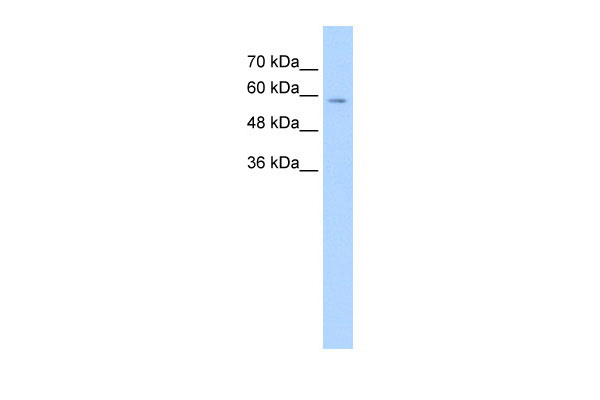CES1 antibody - C-terminal region
Rabbit Polyclonal Antibody
- 产品详情
- 实验流程
Application
| WB |
|---|---|
| Primary Accession | P23141 |
| Other Accession | NM_001025194, NP_001020365 |
| Reactivity | Human, Mouse, Rat, Rabbit, Dog, Horse, Bovine |
| Predicted | Human, Dog, Bovine |
| Host | Rabbit |
| Clonality | Polyclonal |
| Calculated MW | 62521 Da |
| Gene ID | 1066 |
|---|---|
| Alias Symbol | CEH, CES2, HMSE, HMSE1, SES1, REH, TGH, ACAT, PCE-1 |
| Other Names | Liver carboxylesterase 1, Acyl-coenzyme A:cholesterol acyltransferase, ACAT, Brain carboxylesterase hBr1, Carboxylesterase 1, CE-1, hCE-1, 3.1.1.1, Cocaine carboxylesterase, Egasyn, HMSE, Methylumbelliferyl-acetate deacetylase 1, 3.1.1.56, Monocyte/macrophage serine esterase, Retinyl ester hydrolase, REH, Serine esterase 1, Triacylglycerol hydrolase, TGH, CES1, CES2, SES1 |
| Format | Liquid. Purified antibody supplied in 1x PBS buffer with 0.09% (w/v) sodium azide and 2% sucrose. |
| Reconstitution & Storage | Add 100 ul of distilled water. Final anti-CES1 antibody concentration is 1 mg/ml in PBS buffer with 2% sucrose. For longer periods of storage, store at 20°C. Avoid repeat freeze-thaw cycles. |
| Precautions | CES1 antibody - C-terminal region is for research use only and not for use in diagnostic or therapeutic procedures. |
| Name | CES1 (HGNC:1863) |
|---|---|
| Synonyms | CES2, SES1 |
| Function | Involved in the detoxification of xenobiotics and in the activation of ester and amide prodrugs (PubMed:18762277, PubMed:7980644, PubMed:9169443, PubMed:9490062). Hydrolyzes aromatic and aliphatic esters, but has no catalytic activity toward amides or a fatty acyl-CoA ester (PubMed:18762277, PubMed:7980644, PubMed:9169443, PubMed:9490062). Hydrolyzes the methyl ester group of cocaine to form benzoylecgonine (PubMed:7980644). Catalyzes the transesterification of cocaine to form cocaethylene (PubMed:7980644). Displays fatty acid ethyl ester synthase activity, catalyzing the ethyl esterification of oleic acid to ethyloleate (PubMed:7980644). Converts monoacylglycerides to free fatty acids and glycerol. Hydrolyzes of 2-arachidonoylglycerol and prostaglandins (PubMed:21049984). Hydrolyzes cellular cholesteryl esters to free cholesterols and promotes reverse cholesterol transport (RCT) by facilitating both the initial and final steps in the process (PubMed:11015575, PubMed:16024911, PubMed:16971496, PubMed:18762277). First of all, allows free cholesterol efflux from macrophages to extracellular cholesterol acceptors and secondly, releases free cholesterol from lipoprotein-delivered cholesteryl esters in the liver for bile acid synthesis or direct secretion into the bile (PubMed:16971496, PubMed:18599737, PubMed:18762277). |
| Cellular Location | Endoplasmic reticulum lumen. Cytoplasm Lipid droplet. Note=Moves from cytoplasm to lipid droplets upon lipid loading. Associates with lipid droplets independently of triglycerides (TG) content of the droplets and hydrolyzes cholesteryl esters more efficiently from mixed droplets |
| Tissue Location | Expressed predominantly in liver with lower levels in heart and lung (PubMed:10562416). Expressed in macrophages (PubMed:11015575, PubMed:18762277, PubMed:21049984) |
Research Areas
For Research Use Only. Not For Use In Diagnostic Procedures.
Application Protocols
Provided below are standard protocols that you may find useful for product applications.
REFERENCES
Alam,M., (2006) J. Lipid Res. 47 (2), 375-383Reconstitution and Storage:For short term use, store at 2-8C up to 1 week. For long term storage, store at -20C in small aliquots to prevent freeze-thaw cycles.
终于等到您。ABCEPTA(百远生物)抗体产品。
点击下方“我要评价 ”按钮提交您的反馈信息,您的反馈和评价是我们最宝贵的财富之一,
我们将在1-3个工作日内处理您的反馈信息。
如有疑问,联系:0512-88856768 tech-china@abcepta.com.























 癌症的基本特征包括细胞增殖、血管生成、迁移、凋亡逃避机制和细胞永生等。找到癌症发生过程中这些通路的关键标记物和对应的抗体用于检测至关重要。
癌症的基本特征包括细胞增殖、血管生成、迁移、凋亡逃避机制和细胞永生等。找到癌症发生过程中这些通路的关键标记物和对应的抗体用于检测至关重要。 为您推荐一个泛素化位点预测神器——泛素化分析工具,可以为您的蛋白的泛素化位点作出预测和评分。
为您推荐一个泛素化位点预测神器——泛素化分析工具,可以为您的蛋白的泛素化位点作出预测和评分。 细胞自噬受体图形绘图工具为你的蛋白的细胞受体结合位点作出预测和评分,识别结合到自噬通路中的蛋白是非常重要的,便于让我们理解自噬在正常生理、病理过程中的作用,如发育、细胞分化、神经退化性疾病、压力条件下、感染和癌症。
细胞自噬受体图形绘图工具为你的蛋白的细胞受体结合位点作出预测和评分,识别结合到自噬通路中的蛋白是非常重要的,便于让我们理解自噬在正常生理、病理过程中的作用,如发育、细胞分化、神经退化性疾病、压力条件下、感染和癌症。






